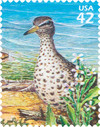
# 4352f - 2008 42c Gr. Lakes Dunes Spotted Sandpip
U.S. #4352f
Great Lakes Dunes
Spotted Sandpiper
Nature of America Series
Issue Date: October 2, 2008
City: Empire, MI
Spotted sandpipers have a characteristic walk that intrigues and baffles scientists. When walking, hunting, or nervous, these birds often move with an up-and-down bobbing motion. This has earned these birds the nickname of “teeter-tail.” Chicks adopt this walk nearly as soon as they hatch. Extensive study of spotted sandpipers has yet to explain why they move this way.
Also of great interest to scientists is the sandpiper’s mating habits. The majority of these birds are polyandrous, meaning the females mate with more than one male. The females arrive at the nesting grounds about four days before the males, establishing their territory. As the males arrive, the females compete with each other over territories and males. These fights often include pecking at their opponent’s head and eyes while simultaneously trying to mount their back.
Each female then mates with a male and the pair builds a nest. In most cases, the female then leaves the male to incubate the eggs while she leaves to find and mate with another male. Females mate with up to five males per year, laying no more than four eggs at a time. As the breeding season goes on, the number of available male sandpipers decreases, as they take on nearly all parental responsibilities.
U.S. #4352f
Great Lakes Dunes
Spotted Sandpiper
Nature of America Series
Issue Date: October 2, 2008
City: Empire, MI
Spotted sandpipers have a characteristic walk that intrigues and baffles scientists. When walking, hunting, or nervous, these birds often move with an up-and-down bobbing motion. This has earned these birds the nickname of “teeter-tail.” Chicks adopt this walk nearly as soon as they hatch. Extensive study of spotted sandpipers has yet to explain why they move this way.
Also of great interest to scientists is the sandpiper’s mating habits. The majority of these birds are polyandrous, meaning the females mate with more than one male. The females arrive at the nesting grounds about four days before the males, establishing their territory. As the males arrive, the females compete with each other over territories and males. These fights often include pecking at their opponent’s head and eyes while simultaneously trying to mount their back.
Each female then mates with a male and the pair builds a nest. In most cases, the female then leaves the male to incubate the eggs while she leaves to find and mate with another male. Females mate with up to five males per year, laying no more than four eggs at a time. As the breeding season goes on, the number of available male sandpipers decreases, as they take on nearly all parental responsibilities.







